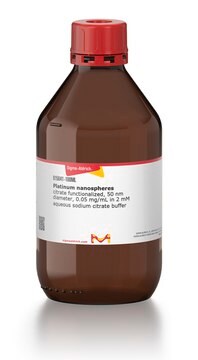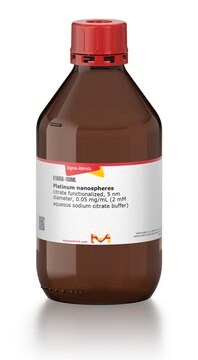推荐产品
品質等級
化驗
99.9% (metals basis)
形狀
nanopowder
反應適用性
reagent type: catalyst
core: platinum
電阻係數
10.6 μΩ-cm, 20°C
粒徑
200 nm (SEM)
bp
3827 °C (lit.)
mp
1772 °C (lit.)
密度
21.45 g/cm3 (lit.)
SMILES 字串
[Pt]
InChI
1S/Pt
InChI 密鑰
BASFCYQUMIYNBI-UHFFFAOYSA-N
一般說明
應用
特點和優勢
訊號詞
Danger
危險聲明
危險分類
Flam. Sol. 1
儲存類別代碼
4.1B - Flammable solid hazardous materials
水污染物質分類(WGK)
nwg
閃點(°F)
Not applicable
閃點(°C)
Not applicable
其他客户在看
商品
Graphene is a unique two-dimensional (2D) structure of monolayer carbon atoms packed into a dense honeycomb crystal that has attracted great interest due to its diverse and fascinating properties.
Electronically, it behaves as a wide band gap (3.2 eV) semiconductor and exhibits memristor properties.2 Optically, TiO2 has high opacity with a very high refractive index3 (>2.4), and it exhibits strong absorbance in the UV range.
The production of hydrogen by catalytic water splitting is important for a wide range of industries including renewable energy petroleum refining and for the production of methanol and ammonia in the chemical industry.
The past several decades have seen major advancements in the synthesis of metal nanomaterials. Most recently, controlled synthesis has become versatile enough to regulate the exact number of atoms and ligands of very small metal nanoparticles, referred to as “clusters”.
我们的科学家团队拥有各种研究领域经验,包括生命科学、材料科学、化学合成、色谱、分析及许多其他领域.
联系技术服务部门





